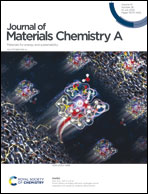TiO2-enhanced in situ electrochemical activation of Co3O4 for the alkaline hydrogen evolution reaction†
Abstract
The use of high-valent metal compounds as efficient electrocatalysts for the hydrogen evolution reaction (HER) is rare. Herein, we report that in situ electrochemical activation is an effective strategy to achieve outstanding catalytic activity of TiO2-coated Co3O4 nanowires (TiO2@Co3O4) in the alkaline HER. The activated TiO2@Co3O4 affords a current density of 20 mA cm−2 at a relatively small overpotential (49 mV), a performance that is superior to that of commercially available Pt/C (20%) and those of most electrocatalysts for the alkaline HER. “Pseudo in situ” spectral characterization and density functional theory calculations suggest that the in situ reduction of Co during the HER results in interstitial Co defects (Coi) in the TiO2. In the activated TiO2@Co3O4, water dissociation is efficient at the Co3O4/TiO2 interface, the Coi defects promote the desorption of the intermediate hydroxyl groups from the TiO2, and the Tafel step is exothermic on Co3O4. Several steps of the HER process are therefore energetically favorable with activated TiO2@Co3O4. The strategy of TiO2 coating and in situ electrochemical activation is also shown to promote the alkaline HER activity of Co(OH)2.



 Please wait while we load your content...
Please wait while we load your content...